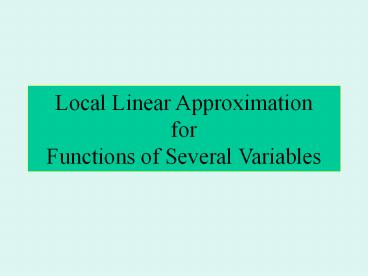Local Linear Approximation for Functions of Several Variables - PowerPoint PPT Presentation
Title:
Local Linear Approximation for Functions of Several Variables
Description:
When we zoom in on a 'sufficiently nice' function of one ... there is some matrix Ap such that F can be approximated locally near p by the affine function ... – PowerPoint PPT presentation
Number of Views:37
Avg rating:3.0/5.0
Title: Local Linear Approximation for Functions of Several Variables
1
Local Linear Approximation for Functions of
Several Variables
2
Functions of One Variable
- When we zoom in on a sufficiently nice function
of one variable, we see a straight line.
3
Functions of two Variables
4
Functions of two Variables
5
Functions of two Variables
6
Functions of two Variables
7
Functions of two Variables
8
When we zoom in on a sufficiently nice function
of two variables, we see a plane.
9
Describing the Tangent Plane
- What information do we need to describe this
plane? - The point (a,b) and the partials of f in the x-
and y-directions.
- The equation of the plane is
- We can also write this in vector form.
- If we write and
10
General Linear Approximations
In the expression
we can think of the gradient as a
scalar function on ?2 This function is linear.
For a general vector-valued function F ?n ? ?m
and for a point p in ?n , we want to find a
linear function Ap ?n ? ?m such that
Why dont we just subsume F(p) into Ap? Linear---
in the linear algebraic sense.
11
Linear Functions
- A function A is said to be linear provided that
Note that A (0) 0, since A(x) A (x0)
A(x)A(0).
For a function A ?n ??m, these requirements are
very prescriptive.
12
Linear Functions
- It can be shown that if A ?n ??m is linear, then
In other words, the function A is just
left-multiplication by a matrix. Thus we
cheerfully confuse the function A, with the
matrix that represents it!
13
Local Linear Approximation
For all x, we have F(x)Ap(x-p)F(p)E(x) Where
E(x) is the error committed by Lp(x)
Ap(x-p)F(p) in approximating F(x)
14
Local Linear Approximation
Fact Suppose that F ?n ??m is given by
coordinate functions F(F1, F2 , . . ., Fm) and
all the partial derivatives of F exist at p ? ?n
, then . . . there is some matrix Ap such that
F can be approximated locally near p by the
affine function
What can we say about the relationship between
the matrix Ap and the coordinate functions F1,
F2, F3, . . ., Fm ? Quite a lot, actually. . .
15
We Just Compute
First, I ask you to believe that if L(L1,L2, . .
., Ln) for all i and j with 1? i ? n and 1 ? j ?
m
This should not be too hard. Why? Think about
tangent lines, think about tangent planes.
Considering now the matrix formulation, what is
the partial of Lj with respect to xi?
16
The Derivative of F at p(sometimes called the
Jacobian Matrix of F at p)
17
Local Linear Approximation
How close does x have to be to p?
So F will be locally linear if F(x)
?Df(p)(x-p)F(p) for all x close to p.
It is easy to see that for all x, we can find
E(x) so that F(x)Df(p)(x-p)F(p)E(x). E(x) is
the error committed by Lp(x) Df(p)(x-p)F(p)
in approximating F(x).
How should we think about the error function
E(x)?
18
E(x) for One-Variable Functions
But E(x)?0 is not enough, even for functions of
one variable!
E(x) measures the vertical distance between f (x)
and Lp(x)
What happens to E(x) as x approaches p?
19
Differentiability of Vector Fields
A vector-valued function F ?n ? ?m is said to be
differentiable provided that there exists a
function E ?n ? ?m such that for all x,
F(x)Ap(x-p)F(p)E(x) where E(x) satisfies































